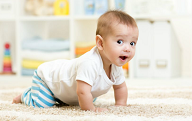Seeing your little one begin to walk is one of the best feelings in the world. However, it is quite terrifying for most parents to see that other children of the same age are toddling but their baby is still crawling. Generally, you should not panic because babies grow at different rates. Nevertheless, you may want to talk to a doctor to rule out the possibility that your baby has an underlying medical problem.
Causes of 18 Month Old Not Walking

If your baby does not walk by 18 months, walking is considered to be delayed. Most children begin to walk by the time they are 11 months; others may take longer and begin at the age of 15 months. However, it is also common for children to be outside of this expected range. A delayed walking does not mean they will not be able to walk at all. Still, it makes sense to talk to a doctor because some other factors can also cause delay in walking. Here are some possible causes:
1. Delay in Motor Maturation
Delayed motor maturation is a term used to describe a child who is normal in all respects other than walking. It means that a child is a late walker but has normal motor skills. Those skills are just delayed. There can be mild hypotonia involved in this situation.
However, it is also possible that a child has severe learning disabilities, which means that you will notice a delay in all developmental areas. In this condition, gross motor development is not highly affected, especially compared to language skills, fine motor skills, and social skills. Hypotonia and dysmorphic features can present.
2. Muscle Tone Abnormalities
- Hypertonia: Delayed walking can be a sign of cerebral palsy, a condition that affects 1 out of every 400 children.
- Muscular Dystrophy: Duchenne muscular dystrophy (DMD) may also be the reason of 18 month old not walking, and Becker's muscular dystrophy is another possibility. DMD is a neuromuscular disease, and this hereditary condition is progressive, which means your baby may be normal at birth but may experience serious symptoms between 4 and 6 years of age.
- Hypotonia: Delayed walking may also be associated with hypotonia, including Prader-Willi syndrome, Down's syndrome, William's syndrome, and Tay-Sachs disease.
3. Environmental Factors
So many environmental factors can contribute to delayed walking in children. Some of the most common factors include malnutrition, head injury, and maternal antenatal infections, such as encephalitis, meningitis, and cytomegalovirus. Sometimes, institutionalized babies who have to be in cots may experience a delay in motor skills.
Treatment for 18 Month Old Not Walking
It is important to talk to your doctor if you believe that your child has reached other milestones normally but has not yet started walking. Generally, you have to see a community pediatrician to resolve the issue, but sometimes, it is a better idea to work with an occupational therapist for better management.
Some children fail to walk because of neglect or poor parenting, which means that they can develop their skills if given an opportunity. In this case, child protection team and health visitor will work together to help these children.
For some complicate cases, a multidisciplinary approach will be necessary:
- Children who have learning disabilities as well usually require physiotherapy to improve their gross motor skills.
- Children who have cerebral palsy may have to work with occupational therapy staff to address developmental problems. Parents will also have to work with community physiotherapy team to learn how to use assistive devices.
- Children with DMD usually require physiotherapy along with support for school. Genetic counseling is of great importance in these families.
18 Month Old Not Walking: What Can You Do to Help Your Child?
You can do a number of things to help your child here. Some doctors recommend the use of a dowel rod to encourage your child. Here is more about it:
- Find a broad space so that the rod will not hit anything. Also, ensure that the rod is not too long or too heavy to ensure that nothing knocks your child over. Your child needs to hold it horizontally.
- Your first goal is to make your child feel comfortable while gripping onto the rod. It is better if he/she can hold it with both hands. Be sure to hold the rod while your child is just getting familiar with it. Do not make your child walk yet because you just want him/her to feel confident before going any further.
- After your child can stand comfortably, you may sit far from him/her and make him/her walk towards you. It is okay if you have to pull your child a little in the beginning, but avoid doing all the work for him/her.
- After your child becomes comfortable using the rod, you can stand beside him/her and walk slowly. This would allow your child to decide how fast or how far he/she wants to walk. Ensure that you do not let go yet. Let your child practice it for some time and build some more confidence.
- After some practice, you can start loosening your grip on the rod, letting your child take more control of things. Just keep your hands there to make your child feel that you are still holding it for him/her. You can let go after some time, but ensure that your child does not notice you doing it. Even if your child fails to go far on his/her own, it is still a good sign. Help your child practice and things will get better.
